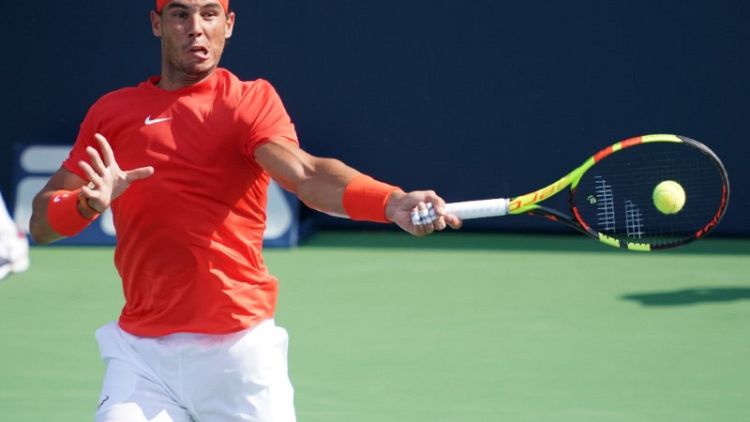By Frank Pingue
(Reuters) - Rafael Nadal's elaborate pre-serve routine will be put to the ultimate test at next week's U.S. Open when a countdown clock makes its Grand Slam debut to help speed up play.
Nadal is a creature of habit and as he prepares to serve the Spaniard bounces the ball a few times, tugs at his shorts, pulls at the shirt on his shoulders, touches his nose and tucks his hair behind his ears before having a few more bounces.
But at the Aug. 27-Sept. 9 U.S. Open in New York the world number one will not have time to add more moves to his lengthy repertoire as a 25-second clock will tick down immediately after the chair umpire announces the score.
Nadal showed he was not bothered by the shot clock during a U.S. Open tune-up in Toronto where he lost only one set en route to collecting a record-extending 33rd Masters title.
The 32-year-old is not a fan of the new measure, although not due to concerns about receiving a time violation but rather because he feels it will diminish the quality of play.
"My experience in the world of tennis at the matches that became part of the history of our sport are not matches where the duration... is one hour thirty, you know?" said Nadal.
"The matches that the people remember are matches that are epic, the matches that the people get involved (in).
"My experience is I don't see people get crazy and involved in the match when the ball, all it goes (is) two or three times over the net every time," he added.
"I see the people go crazy and enjoy and feel the passion for the sport when you have rallies of 15, 20 balls.
"...that's my feeling. And when you have continuous rallies of that kind, you can't be ready physically to play another point like this in 25 seconds. That's my point of view."
MORE TIME
Novak Djokovic has also taken tennis idiosyncrasy to another level with a pre-serve routine in which he bounces the ball with his racket before shifting it to his left hand and bouncing it sometimes over 30 times before finally tossing it into the air.
The Wimbledon champion, who won last week's U.S. Open tune-up in Cincinnati, said he was comfortable with the shot clock and did not feel it affected him negatively.
"On the contrary, I actually feel like there is more time now than before because the shot clock starts counting down once the chair umpire calls the score," said the Serb.
"Sometimes it takes several seconds before the chair umpire calls the score if it's a long exchange or a good point and the crowd gets in."
If a player has not started the service motion at the completion of the 25-second countdown, the chair umpire will issue a time violation.
U.S. Open champion Sloane Stephens said the shot clock will not change the way she plays but felt it could add another level of distraction when you are awaiting serves from an opponent.
"It's a lot of... can I say human error? If the umpire doesn't start it right away, you think, 'If they started it five seconds earlier, the person you're playing would have got a serve warning'," said Stephens.
"It's things like that you don't really want to be thinking about. It just adds another element if something goes wrong, it can go terribly wrong."
(Reporting by Frank Pingue in Toronto; Editing by Ken Ferris)
